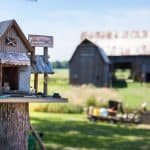Choose whichever adjective you prefer: “majestic”, “awe-inspiring”, “monumental”, “colossal”, “magnificent”. There really are no wrong words when it comes to describing the giant sequoia trees of California’s High Sierra forests. But the one that kept coming to mind as Henk and I walked amongst these towering titans in Kings Canyon and Sequoia National Parks, was “unbelievable!” Tragically, that one particular adjective led to the ultimate crime against Mother Nature: the felling of millennia-old giant sequoias in the 19th century as ‘trophy trees’, just to prove to the world that they had existed in the first place.
The ‘California Hoax’
It was 1875, the year before the Philadelphia Centennial Exhibition celebrating the 100th anniversary of the founding of the United States, and Californians were no doubt keen to show off some of their west coast wonders at the exhibition. Some of the most spectacular of these were their native giant sequoia trees, but rather than just talk about these huge trees or show photographs of them to visitors, one entrepreneurial man decided to go even further…
Martin Vivian had already been convicted and fined for illegally cutting down large trees in California, but state law prevented anyone from being tried for the same crime twice. Taking advantage of this legal loophole, Vivian had a plan for the 1876 Exhibition: he would cut down one of the biggest trees in what is now King’s Canyon National Park and ship a section of it to Philadelphia to showcase the scale of these Pacific beauties (and probably gain himself some notoriety in the process). But shipping even a small section of the felled tree in one solid piece was impossible to manage, so instead, he sent a hollow 16-foot tall section of its outer bark ring to Philadelphia to be put on display for the public.
Unfortunately, even these pieces had to be sectioned in order to move them across the country, and the somewhat crude reassembly of this outer bark ring left dubious easterners unconvinced of the tree’s authenticity. In fact, they refused to believe that any tree with a circumference this huge could actually exist at all and the entire debacle became known as the ‘California Hoax.’
No proof of existence, no public accolades, and worst of all, one less old growth sequoia in the forest.
TIP: The stump remnants of the ‘Centennial Tree’ of 1876, as it came to be known, can still be found in King’s Canyon National Park, where a placard is placed to commemorate its felling.
The Columbian Exposition of 1892
Fast forward 16 years. It is now 1892, a year before the World’s Columbian Exposition (aka the World’s Fair) is set to open in Chicago. The ‘Columbian’ theme was meant to honour the 400th anniversary of Christopher Columbus’ first voyage to America, and naturally the United States was looking to put their most impressive exhibitions on display to the visiting world, California included. Calls were put out far and wide to all the governmental agencies across the country, and perhaps Californians, still stinging from the ‘Hoax’ from 16 years previous, had even more to prove with this Fair.
The ‘General Noble Tree’
For the Chicago World’s Fair, California wasn’t going to make the same mistake twice – except that from a preservation standpoint they sadly did, worse even than Vivian’s destruction of the Centennial Tree: this time they chose to cut down one of the largest giant sequoia trees in the world, unfortunately located outside of the protected area of Sequoia National Park, which had been established two years previously as America’s second National Park specifically to prevent logging of these beautiful giants.
California’s Tulare County went to the company who had the logging rights to the forest, (Smith and Moore Co.), and paid them $5000 (about $140,000+ in today’s dollars) to cut down the largest giant sequoia tree in the Converse Basin Grove. It is said that the foreman, a man named Franklin A. Boole, couldn’t bring himself to destroy the largest tree in the grove, so they selected the second largest one instead.
Taking Down a Giant Sequoia Tree
The felling of such a massive specimen, which became known as the General Noble Tree, after the U.S. Secretary of the Interior at the time, was a herculean task in and of itself. A team of road-builders, loggers and engineers first had to build a road to reach the remote location. They then proceeded to build a 50-foot tall scaffolding in order to cut through the tree at 52 feet above the ground where the diameter of the trunk was still almost 20 feet across.
Five men sawed through the massive trunk taking 13 days to complete all the cutting. The men almost died when the tree crashed down prematurely after the first cross-cut, forcing the men to jump onto the exposed stump just before the falling tree destroyed their scaffolding.
According to reports, it took 20 minutes for the vibrations in the forest to cease, which must have been a terrifying – and devastating – event to witness.
As tragic as this crime against Mother Nature was, it served its purpose at the time. The carefully transported pieces of a 40-foot tall section of the trunk was successfully reassembled in Chicago, including the interior pieces, so that there would be no debate about the authenticity of this tree. It was exhibited in the rotunda of the Government Building at the Fair and no doubt invoked wonder and amazement in everyone who saw it.
The world may not have come to California to see the sequoias, but California had brought the sequoias to the world, and proven once and for all that these giant sequoia trees actually did exist. Sadly, it was only after one of the finest specimens of the Sequoiadendron giganteum trees had been destroyed, that they came to be known and appreciated.
EVEN SADDER FOOTNOTE: Years after it was felled, further examination of the tree rings in the remaining stump (now called the ‘Chicago Stump’, showed that the General Noble sequoia was over 3000 years old when it was cut down. And there would be more than a dozen other ‘trophy trees’ that would fall to the axe for the same reason in the years that followed, not to mention the thousands of other old growth giant sequoia trees from California that would be cut and turned into often unremarkable wood products.
HAPPIER FOOTNOTE: The larger tree that was spared when the General Noble Tree was chosen instead was later named the ‘Boole Tree’ after the foreman who refused to cut it down. Today the Boole tree is still alive and well in Kings Canyon National Park and holds the title of the sixth-largest tree on the planet.
Protecting a Legacy for Today and Tomorrow
There’s no bringing back 3,000 year old trees. And there’s no turning back the clock 150 years to educate or regulate about the need for preservation and conservation of natural resources and treasures like the giant sequoia trees. But we do seem to have learned from our mistakes and today there are many organizations (including governmental and not-for-profit entities) that have made it their mission to protect the giant sequoias and redwoods, not just from ourselves but from other natural threats like fire, disease and pests. But it’s an uphill battle: in the past few years, wildfires alone have destroyed 10,000 trees – almost one fifth of all giant sequoia trees in California.
We can only hope that with our help, and a little help from Mother Nature herself, three thousand years from now our own future generations will still be able to stand beside these giants and marvel at their proven-but-still-unbelievable size and beauty. Fingers crossed we have that kind of foresight.
“If I have seen a little further, it is by standing on the shoulders of giants.” Sir Isaac Newton























A giant of an article about a giant of nature.